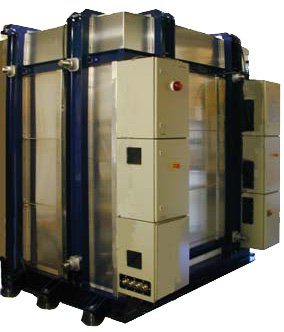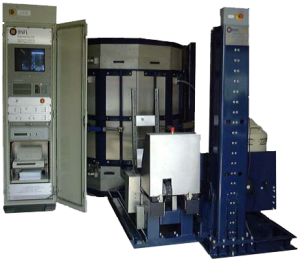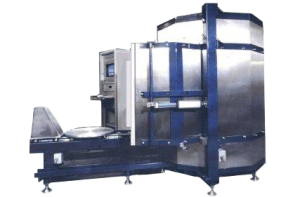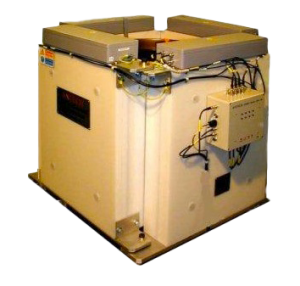The ANTECH N2240 Active-Passive Drum Monitors (Differential Die Away) Series are enhanced efficiency active-passive neutron counters for the measurement of plutonium and uranium in nuclear waste.
The neutron detection system consists of 90 ³He tubes embedded in a cadmium clad polyethylene moderator and arranged in 18 fast detector packages (three per side). Each package is connected to a high voltage junction box containing an Amptek charge sensitive amplifier/discriminator circuit and connections for high voltage, low voltage and signal cables.
Polyethylene back shielding is provided to reduce the effects of ambient background. The other surface is covered in stainless steel cladding and the graphite liner is clad in aluminium.
The N2240 Series can be operated in conventional totals active mode or the more advanced Fission Fission passive neutron correlation coincidence counting (reals) mode. This latter mode reduced the amount of effort required to calibrate the measurement system.
- Capable of the measurement of low levels of fissile and fertile material in waste
- Capable of both 'active' and 'passive' operation for the measurement of fissile and fertile nuclides
- Long die-away time (>1 ms) and high neutron detection efficiency
- Aimed at European and USA low level waste consignment limits and LLW/TRU segregation in the USA
Benefits
- Semi-automatic drum loading capability
- Thermo Scientific (MF Physics) zetatron neutron (D-T) generator of proven high reliability
- 18 x fast neutron detector packages
- State of the art multi-channel scaler and time correlation analyser
- Operation in conventional active totals neutron mode or in coincidence counting mode using the Fission Fission neutron Correlation method
Features
-
Description
In conventional active totals mode, pulses of neutrons are used to interrogate a waste drum placed in the measurement chamber. A neutron generator is pulsed at 100 Hz producing 14-MeV neutrons. The neutrons are slowed down in graphite providing a source of thermal neutrons that cause induced fission in the ²³⁵U and ²³⁹Pu in the waste. Each pulse generates approximately 1 x 106 neutrons. Cadmium shielded detector packages are used to measure the prompt fission neutrons (from induced fission) in a time period (after a delay of 500 µs) when neutrons from the initial generator burst have been cleared from the fast detector packages. At a generator frequency of 100 Hz, each measurement period is ~10ms. Neutrons are counted in an early gate (0.8 ms to 3.0 ms) and a late gate (6 ms to 9.5 ms).
The measurement result is the separate sum of many early and late gates as the overall measurement time is typically 5 minutes or more. Additional ³He flux monitors are placed in the measurement chamber and provide a measure of the interrogating neutron intensity and its die-away characteristics. A later time period is used to determine the background due to delayed neutron production from fission products and from any spontaneous fission nuclides present. The fissile mass is proportional to the net fissile signal normalised to the interrogating flux. The system is calibrated for uranium and plutonium mass using representative matrices.
Passive mode operation uses conventional neutron counting of the correlated neutrons arising from spontaneous fission of the even plutonium nuclides, principally ²⁴⁰Pu. Plant measured isotopic ratios (from high resolution gamma-ray spectrometry) can be used by software in order to convert ²⁴⁰Pu effective mass to total plutonium mass.
-
Specifications
Sample Chamber DimensionsModel N2240-220 : 1060mm x 760mm x 760mm
(41.7in x 30in x 30in)
Model N2240-440 : 1250mm x 850mm x 850mm
(49.2in x 33.4in x 33.4in) Height x Width x DepthDimensions6100mm x 2500mm x 2500mm
(240.2in x 98.5in x 98.5in) Height x Width x DepthWeight11,500 kg Approx.Sample SizeModel N2240-220 : 200 L
Model N2240-440 : 400 LNeutron Detector90 x ³He detector tubes, 25.4 mm at 4 atm pressure () 1 in






